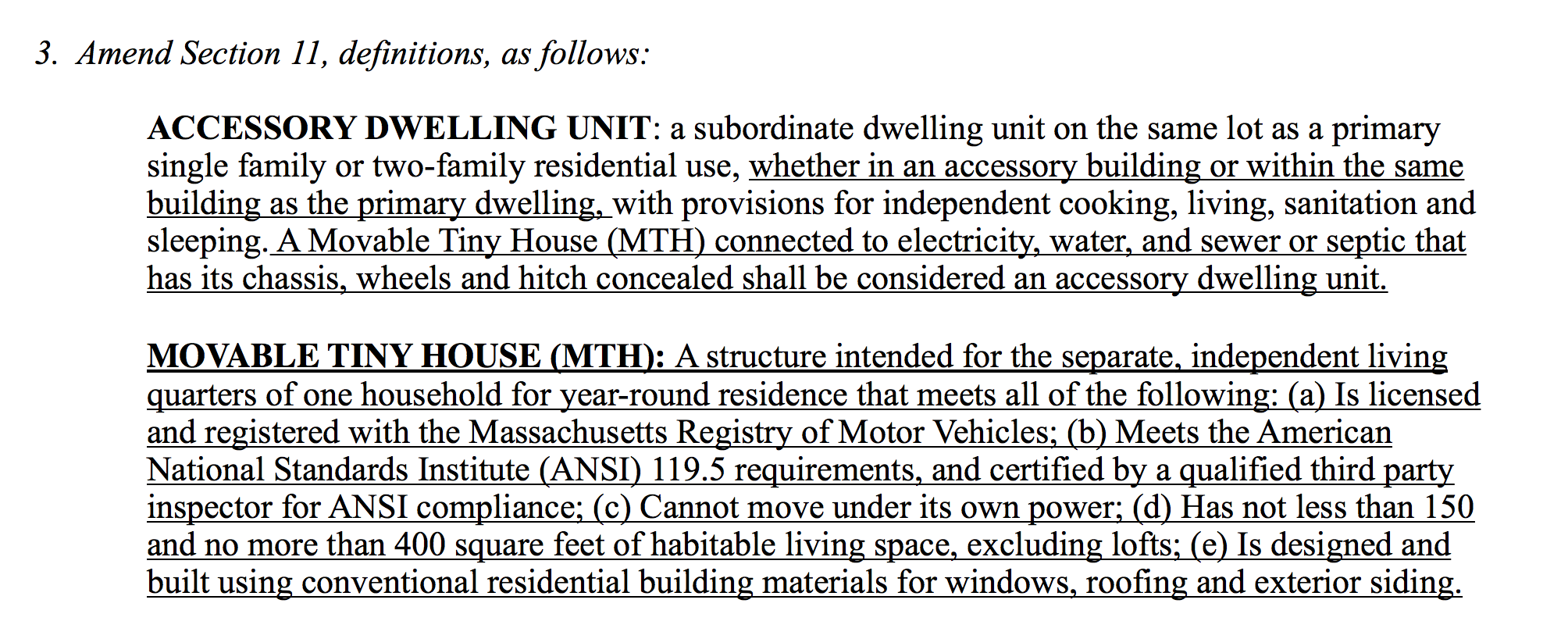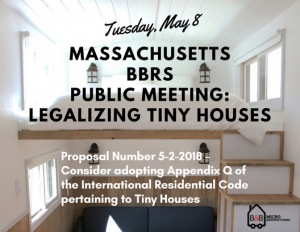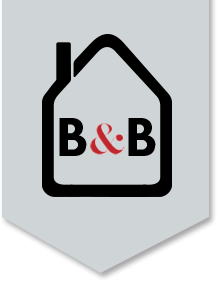Business Ideas for Tiny Houses
Learn how tiny houses can make your business dreams come true!
Learn how tiny houses can make your business dreams come true!
What is the difference between a Tiny and a Small House? Learn everything you’ll need to know here!
If you live in New Hampshire, please email the chair of the Tiny House Study Committee, State Rep Dave Testerman at [email protected] to express your support for the adoption of Appendix Q for tiny houses on foundations.
The public comment period for Connecticut residents is not open yet. When it opens up, this post will be updated with the contact info.
The following information on Appendix Q is adapted from our previous blog post, written when Massachusetts adopted the Tiny House Appendix.
Appendix Q: Tiny Houses provides building safety standards for houses on foundations that are 400 sq. ft. and under. The other building codes in existence for all other size dwellings still apply. Appendix Q is was created to define safety standards for smaller spaces that wouldn’t necessarily fit into a tiny house, such as a full-size staircase.
The Appendix pertains to the following aspects of designing a small or tiny house:
Read the entire text of Appendix Q: Tiny Houses here.
Not quite! Every zone of every municipality in the state still has its own zoning bylaws. Therefore, you’ll need to contact your municipality to see if they’ll allow your tiny-house-on-a-foundation project. Here’s how.
Here’s what the Tiny House Appendix does mean for residents of states that have adopted Appendix Q: wherever a house that’s 400 sq. ft. or under is allowed, there are now rules in place for how to build it safely and effectively. Before, small and tiny houses on foundations would have had to adhere to certain building codes that work well for large buildings but would have been impractical or impossible to follow in small spaces.
Building code provides a set of safety standards that new buildings must adhere to by law. These standards ensure the safety of the people using the building. There are separate building codes for residential buildings (like houses and apartment buildings) and all other buildings (like shops, factories, schools, and workplaces). The Tiny House Appendix is set to become part of the state building code in NH and CT, which is based on the International Residential Code (IRC). Most, but not all, states in the USA use the IRC as the basis for their state-wide building codes, and adapt each section as necessary.
Zoning code pertains to what types of buildings municipalities (cities and towns) allow, and where. Often a city or town has several different zones, and each zone has different rules. Zoning bylaws are decided by the zoning board of a city or town, and can be amended to better fit the needs of each city or town. Zoning boards generally have regular meetings that are open to the public, where the public can share their concerns, get clarification on what is allowed to be built, and request a change to the zoning bylaws to improve their municipality.
How can the Tiny House Appendix influence local zoning officials? Appendix Q as part of a state’s building code serves to legitimize tiny and small dwelling spaces in the eyes of local building inspectors and zoning boards. Municipalities that see there are ICC-approved codes to build tiny and small houses may be more inclined to adopt those types of homes into their zoning.


Left: Appendix Q applies to tiny houses on foundations that are 400 sq. ft. or under.
Right: Appendix Q does not apply to tiny houses on wheels.
Currently, the Tiny House Appendix, or Appendix Q, only regulates houses that are permanently-affixed. It does not relate to tiny houses on wheels. However, there is a movement to create a new version of Appendix Q for tiny houses on wheels as well. Martin Hammer, Andrew Morrison, and Gabriella Morrison were instrumental in introducing Appendix Q to the International Building Code and then again to individual states. See their website for more info on future plans for a tiny house on wheels appendix.
B&B Micro Manufacturing would like to give a shout-out to the Tiny Home Industry Association for its tireless research on tiny house laws across the nation and the American Tiny House Association for its influence on state policy!
The tiny house amendment has gone through all the previous stages of approval: registered voters in Great Barrington will vote on whether to allow them at the annual town meeting on May 6.

Katie Jackson of B&B Tiny Houses was asked to do a presentation at a planning board meeting on what tiny houses are, how they work, and how other cities have written them into their zoning code. Katie is also the Northeast Regional Director of the American Tiny House Association, which is hosting the open house on May 5.
Here’s our previous update on Great Barrington’s consideration of allowing tiny houses on wheels.
Here’s an article on Great Barrington’s Town Meeting from the Berkshire Edge.
Backyard tiny houses will add density without having to change the infrastructure of the town; it’s the quickest, easiest solution (and one of many) that will address the housing crisis.
Here’s Great Barrington’s proposed zoning language pertaining to tiny houses:

Acronym Key:
MTH: Movable Tiny House
THOW: Tiny House on Wheels
ADU: Accessory Dwelling Unit
-Tiny House Open House in the backyard of 65 Anderson Street, Great Barrington, MA 01230. Sunday, May 5, 10am-4pm.
Sunday’s tiny house open house is in advance of Monday’s Great Barrington Annual Meeting, where a proposed zoning amendment allowing Movable Tiny Houses as accessory dwelling units will be voted upon, among other topics. The open house is hosted by Amy Turnbull who is on the leadership team of the American Tiny House Association, with a movable tiny house built by Tony Indino of East Granby, Connecticut (this house is shown in the event flyer). This open house will give a glimpse into what backyard tiny houses might look like in Great Barrington if the Movable Tiny House Amendment passes.
-Great Barrington Annual Meeting & Vote at Monument Mountain High School Auditorium, 600 Stockbridge Rd, Great Barrington, MA 01230. Monday, May 6, 6:00pm.
Please attend the Annual Meeting on Monday in support of allowing movable tiny houses in Great Barrington backyards. The proposed amendment language is posted in the comments. All those who are registered to vote in Great Barrington may vote on the amendments.
 Meeting Addressing Tiny Houses in Massachusetts’ Building Code
Meeting Addressing Tiny Houses in Massachusetts’ Building CodeLast week on May 8, 2018, the Massachusetts Board of Building Regulations and Standards (BBRS), at its regular monthly meeting, addressed Proposal Number 5-2-2018: “Consider adopting Appendix Q of the International Residential Code pertaining to Tiny Houses.” The agenda is here; minutes (an official summary of the meeting) should be forthcoming. Along with Appendix Q, micro-apartments were also addressed.
This meeting was one step in the process of Massachusetts’ adopting the Tiny House Appendix into its building code, following the example of other tiny house pioneering states Idaho, Georgia, and Maine. The next step after this meeting will be an internal vote within the BBRS (not a public vote), which will take place next month. Before voting, the BBRS is accepting public comment on Appendix Q: the address is at the bottom of this post.
Appendix Q addresses building code standards for small houses on foundations that have already been adopted into the 2018 International Residential Code (IRC), including standards for lofts, stairs, egresses, and ceiling heights. To be clear, the adoption of the Tiny House Appendix won’t completely legalize tiny houses in Massachusetts– that’s up to each city– but if it is adopted, it will provide a set of building standards for under 400 sq ft homes where they are legalized, and where they aren’t yet legalized, help legitimize tiny homes in the eyes of local building departments. Appendix Q does not address tiny houses on wheels, as they are currently considered vehicles.
Read the Tiny House Appendix here.
Andrew and Gabriella Morrison have been instrumental in writing and getting the Tiny House Appendix adopted into the 2018 IRC: now it’s up to each state, and then each city/town in each state, to adopt it into their specific building code. Andrew presented at a Massachusetts BBRS meeting, introducing Appendix Q last fall. Before last week’s follow-up meeting, Andrew said, “The last time I was there, the main question was why should tiny houses get “special treatment”: their own code provisions? I responded that it’s about safety. People are building tiny houses all over the place and with NO oversight. The appendix allows code enforcement to make sure that the tiny houses are built well and to safety standards. It’s about providing healthy, safe housing to millions of people who need it and don’t otherwise have access to it.”
Of the tiny house portion of the meeting, Richard Crowley, Chair of the Mass BBRS, said: “There were quite a few people who came to the front to speak. One lady was very animated and she was so cool she made everyone laugh. Very enjoyable speech. I put my two cents in and away we go. I don’t think [there will] be any problem next month getting a positive vote. FYI if anyone wants to comment they can do so to the attention of Rob Anderson at the BBRS.”
Raines Cohen, a cohousing coach who attended the meeting, said “All speaking in favor but one comment afterwards during the micro homes referenced tiny homes and brought up concerns around disability access standards… Some informed questions, coming from the fire-chiefs head.”
The BBRS is inviting public comment on the tiny house appendix until June 1, 2018***. Please write to:
Robert Anderson, Chief of Inspections- Building Division, MA Department of Public Safety
Email: [email protected].
Letters: One Ashburton Place, Boston 02108
*The paragraph “Next Steps…” was added on 5/15/2018.
** The original date for the June meeting was June 12; now it is June 5.
***As of 5/18/18, the comment deadline has changed to June 1.
 You’ve found beautiful land, but can you put a tiny house on it?
You’ve found beautiful land, but can you put a tiny house on it?Although many people dream of a completely off-grid tiny house in the middle of nowhere, you’ll still need to find a way to get water and power to your house. The less distance from the road, the less expensive it’ll be to have power and water lines installed.
For electricity, the cheapest and easiest option is to plug into an existing power source. Others choose to power their homes with solar power. Click here to learn more about solar power for tiny houses.
For fresh water and waste water, city water and sewer are one option; pieces of property in less dense locations that don’t have city water and sewer will need to use a well and septic systems.
If the land already has electricity and water hookups, you won’t need to worry about having those put in. Generally, although not always, it’s less expensive in the end to buy land that already has utilities than buying land without and then paying to have them installed. Be sure to factor in these costs when looking for land.
Not all tiny houses are certified, but the turnkey tiny houses on wheels B&B builds are certified by the Recreation Vehicle Industry Association, or the RVIA, meaning they are built to high safety standards that the government can understand, they can be financed as RVs, and they can be parked anywhere RVs can go, using RV hookups to get water and electricity to the house and wastewater from the house (Click here to read more about RV hookups on tiny houses). Use the search terms “RV”, “Recreation Vehicle”, “Recreational Vehicle” in your town’s zoning code to see if RVs are allowed in your property’s zone. Building codes won’t apply to RVs since they are legally considered vehicles rather than buildings.
Here’s more info on how to find out if your town allows tiny houses.

Although people have been traditionally living in very small living spaces since the beginning of humanity, in more recent history, tiny houses are a relatively new phenomenon in our modern western world. Therefore, most towns don’t already have tiny houses written into their zoning or building codes. If this is the case, don’t be discouraged: it doesn’t mean you can’t do it, it just means you’ll have to introduce the concept to the zoning board. In this blogger’s experience, zoning boards are made up of passionate people who want to find housing solutions for their towns. With tiny house TV shows and news stories all but taking over television networks, no doubt at least a couple of the folks on your town’s zoning board will already have an idea of what tiny houses are. They’ll let you know whether you need a special permit to have a tiny house on your property, and if so, guide you through the process.
Learn more about our process or fill out the form below and one of our tiny house experts will reach out to you.
